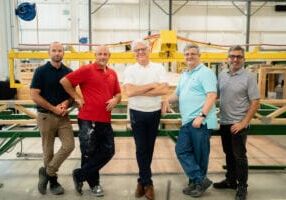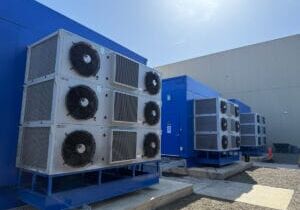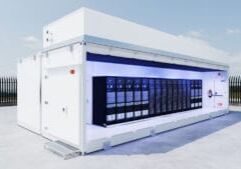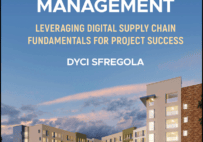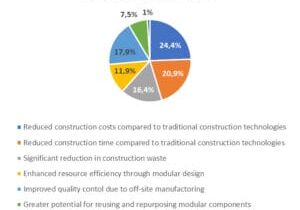The Potential and Possibilities of AI for Offsite

Jennifer Castenson is a contributing writer for Forbes.com
AI is everywhere. Many industries have incorporated AI into business as usual with new organizational structures and new dependencies to be more efficient and to automate repetitive tasks.
Offsite construction will not be immune to AI’s ubiquity. The technology offers unique benefits to the offsite building process.
Managing Change
Brent McPhail is an offsite specialist and founder of Brave Structures who has translated years of experience in automobile manufacturing into manufacturing housing.
Where automative manufacturing is able to set up a factory, make a million trucks, then tear down the factory based on a set of static variables, housing projects are all unique, leading to challenges in standardizing processes and achieving economies of scale.
“What volume of factory home building would we have to get to to use robots as a specialist,” McPhail wondered. “You cannot have purpose-built robots to just build a frame. Building the frame isn’t much of a challenge, it’s putting in the MEP. If you are going to have a robot build the frame, then continue that to sheath it, put in MEP, then you get the ROI. All the value add is where it makes a big impact.”
So, the challenges that need to be addressed in housing are different than the challenges in automotive manufacturing, which is where offsite can benefit from AI. AI can help watch and learn patterns to ultimately have a higher level of control, efficiency and production.
“For instance, AI can track where people are in the facility and create a heat map of what people spend time on,” he said. “By tracking time and space of when people are in different areas, AI could inform us that a worker needs to stay at his station instead of going back and forth, creating efficiencies in the process.”
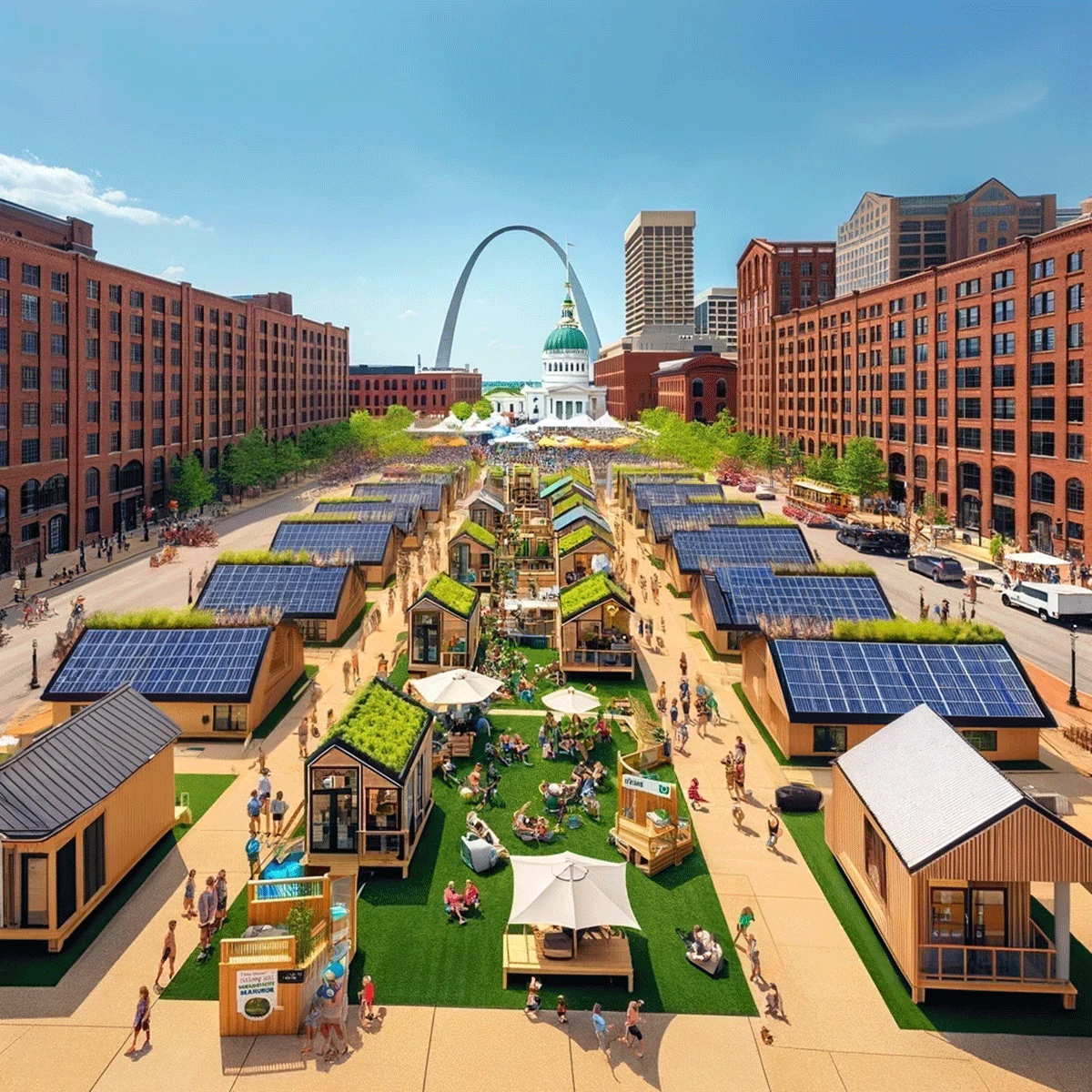
Gateway Decathlon competition village conceptual rendering developed using AI generative design software alongside Bobby Vance.
Lightening the Labor
Offsite construction can be more complex than conventional construction, which requires more advanced solutions than traditional single-function machines like CNC equipment, McPhail added. AI can optimize the setup and changeover processes for robotic systems in this context.
With adaptive learning and programming, AI helps robots learn from previous tasks and apply that knowledge to new, similar tasks. For example, if a robot has been taught to fasten screws, AI can help it generalize that task to nails, rivets, or even welding, based on the materials and requirements of the current project.
AI can manage and optimize the tool changeover process, selecting the appropriate tools based on the specific task and material to always use the most efficient tool for the job. Plus, AI can predict the optimal sequence of tasks for a given construction project, so the work is performed in the most efficient order.
Without AI tools, there can be schedule shortcuts by doing onsite work parallel to offsite work.
“The struggle with that is not knowing how to produce the parts to have it optimally assembled on site,” said Bobby Vance, competition manager at the Gateway Decathlon, an international competition to use offsite methodologies to accomplish more with housing. “AI can optimize how parts are made and delivered. If there is a delay, it can determine what needs to adjust itself to keep things moving in a smooth manner. Schedule is so important, because if there is a glut or lull, a lot of builders go out of business because they cannot support the equipment investment.”
By automating much of the programming and setup required for robotic systems, AI reduces the burden on technicians and speeds up the deployment of robots on new projects. This lowers the overall cost of using robotics in offsite construction and improves the return on investment.
Value Engineered Design
Generative design can instantly create multiple design options based on certain criteria, and support architects in the understanding of the possibilities of the particular lot of land with its specific weather patterns, said Joseph Burak, founder and chief strategist at TRANSiT Strategy & Analytic. The design parameters also can take into consideration overhead, transportation logistics, equipment, the amount of labor needed on site.
By using an AI tool to look at design specifications, you can run a million simulations to predict the inputs, the cost, the materials, and the labor, he explains. The AI can add up the widgets, nails, and then look at the design element and tell you how to modify the structure to save ‘x’ percent of dollars, doing it all in a matter of minutes.
Plus, AI can crunch design specifications, takeoffs, and estimates in minutes, reducing hours or days of work for professionals.
“Ideally, you can refine the options as you give it more logic and more parameters to be an interactive design tool,” Vance said. “Studs, tracks, electrical, planning… There are so many decisions to coordinate behind the wall, but what I see is the wall and the only thing I care about is what the wall looks like. Still, I need to quickly, in real time, make aesthetic decisions that have structural and systems impacts.”
AI can automatically synthesize this process to determine when something is out of range for a tolerance and give a new set of parameters to consider. Plus, AI can quickly look at all the data behind material selection that can take a designer a long time to do.
“It can help for sourcing materials for cost and for availability,” he said, emphasizing the cost analysis. “You cannot overlook cost. AI can look at cost in real time availability. It can look at the different metrics of ordering something in bulk to see if there is a discount.”
AI can help identify manufacturing constraints at design time to inform the architects and engineers how to make different choices to have the lowest impact on manufacturing, McPhail said, using the terminology “Design for Manufacture and Assembly – Refine for Automation.”
Manufacturing Efficiency
With current labor shortages, AI-powered tools can boost productivity by providing workers with real-time guidance, augmented reality instructions, and automated quality control checks. AI can also identify skill gaps and recommend targeted training programs, helping to upskill the workforce more efficiently.
McPhail explains that each offsite construction project is a snowflake, making it difficult to use traditional manufacturing metrics like Overall Equipment Effectiveness and Overall Labor Effectiveness.
“AI can overcome these challenges by analyzing complex manufacturing inputs, including machine performance, labor efficiency, and project-specific variables, and organizing them into meaningful insights,” he said. “AI-driven systems can dynamically adjust based on the specific context of each project, detecting machine and labor bottlenecks with greater accuracy.”
The prefabrication and assembly processes require a specific sequencing of manufacturing operations with the equipment and the factory space, so AI can be used to find the most effective process for the build, Burak said. Plus, AI will set out the onsite assembly process, identifying the most efficient use of tools on that site to be most effective.
“On the project management side, AI can find the most efficient path, minimize project delays by creating multiple schedules for the same build to find which simulation and model best fits this particular build,” he said. “Most contractors have a system and take the mindset of if it isn’t broken don’t fix it, but the AI will help find a more efficient critical path that can result in time or cost savings.”
AI also improves the process in both time and resource efficiency. McPhail says AI-driven systems can analyze production schedules and batch tasks to maximize material use, like keeping cut pieces for later use in other parts of the project.
“Look-ahead features allow AI to anticipate future material needs and optimize cutting patterns in real-time, ensuring that materials are used as efficiently as possible,” he said. “Cut optimization algorithms can determine the best way to cut materials to minimize waste, automatically adjusting to changes in design or material availability. This approach not only reduces material waste but also lowers costs and improves overall sustainability in the construction process.”
Quality Control
The human eye is pretty amazing, but with AI assistance, quality control can be improved to detect what the human eye cannot.
AI-powered vision systems, equipped with computer vision and machine learning technologies, can automate the quality control process using high-resolution cameras and sensors to continuously monitor and inspect components as they are produced. This improves the accuracy and reliability of quality control, and also speeds up the inspection process.
Offsite construction involves a wide range of materials, each with different properties and quality control requirements. Ensuring consistent quality across these diverse materials is more challenging than in automotive manufacturing, where materials are more standardized, McPhail said.
Complex Regulatory Compliance
The human eye is pretty amazing, but with AI assistance, quality control can be improved to detect what the human eye cannot.
AI-powered vision systems, equipped with computer vision and machine learning technologies, can automate the quality control process using high-resolution cameras and sensors to continuously monitor and inspect components as they are produced. This improves the accuracy and reliability of quality control, and also speeds up the inspection process.
Offsite construction involves a wide range of materials, each with different properties and quality control requirements. Ensuring consistent quality across these diverse materials is more challenging than in automotive manufacturing, where materials are more standardized, McPhail said.
Logistics and Transportation Challenges
Transporting large modular components from the manufacturing facility to the construction site involves significant logistical challenges, including route planning, regulatory approvals, and the risk of damage during transit.
“With offsite, you are building something somewhere and it has to get somewhere else,” Vance said. “If you plan for it to have this many parts, how can it efficiently pack onto a transportation vessel looking at logistics and a size and weight perspective and how does that information back feed into design parameters.”
AI can optimize logistics by analyzing transportation routes, predicting potential obstacles, and planning the safest and most efficient delivery paths. AI also can monitor weather conditions and adjust transportation plans in real time to mitigate risks, and so components arrive intact and on schedule.
AI Limitations in Offsite
With all new concepts, there are risks and limitations.
Tyler Pullen, senior technical advisor at Terner Housing Innovation Labs, points out that the construction industry has relied on relationship-driven processes and structurally fragmented information streams and decision making, which offer few opportunities to drive continuous improvement on an individual, organizational, or sector-wide level.
“In short: it’s human, and it’s systemic,” he says. “This doesn’t mean there’s no chance for AI and similar tools to play a part, it simply means the path to scale impact is bottlenecked by many of the same issues that have converged towards our dueling housing and climate crises.”
Some companies are breaking through those characterizations. For example, BuildCheck.AI can automate compliance checks during plan review for local jurisdictions and is kicking off with some pilot projects in California. In addition, Symbium uses AI-adjacent tools like large language models to interpret the tangible constraints otherwise embedded in hundreds and hundreds of pages of zoning and building code text.
“Applications like these are interesting in that they might do a better job, with plenty of caveats and related risks, of interpreting our own local codes and compliance metrics than we do, and address an often-underemphasized challenge of understaffed, overworked local planning and building departments nationwide,” Pullen said.
There’s also possibility for AI writing tools like ChatGPT to streamline a project’s documentation workload, such as drafting scope documents and related contracts across subcontractors, financing proposals, and administrative reporting of metrics like labor hours and equipment usage to inform and revise draw-down schedules.
“The usefulness of AI will likely be limited by the same existing bottlenecks that make these pain points in the first place, but the ability of AI tools to manage, make sense of, and operationalize complex, orthogonal information could nonetheless find perch in an industry where that’s basically all we do, all of the time,” Pullen said.
Is AI Right For You?
Determining if leveraging these features of AI is right for you should be a thorough process with multiple stakeholders. Burak recommends starting with a third-party value chain analysis with a manufacturing process audit to understand the inputs to all the operational steps.
“This will allow you to understand the most valuable parts to offload to AI,” he said. “You can understand how much time is spent on each component, and the cost input for each unit, then identify how AI in each part is implemented to save time.”
The process will also uncover other options rather than AI.
“There is a sense that there is an AI tool that can handle everything, but there is not,” Burak said. “It’s about identifying where it provides value as part of your proprietary process.”
He advises that you should check on the following:
- What are the intellectual property challenges?
- Is it being built for your company?
- Will you be subscribing to a plug in to run 10,000 scenarios?
- Who owns it?
- How much do you pay for it?
- What NDAs will you need to protect intellectual property
“It’s important to identify where AI makes the most sense in a proprietary process, considering cost-effectiveness and intellectual property questions,” Burak said.
The Future of AI in Offsite
The future depends on our willingness to adopt and adapt.
“Right now, the offsite industry is trying to mimic what the current industry does,” Vance said. “It fails inherently because local economics, but that would kill a factory supplying more than just that region. We can source things better within an ecosystem where we can have access to different projects, a sharing system, to maintain an equilibrium. It needs a universal platform.”
There are many different levels of automation in the industry that need to be understood and embraced for a more productive future.
“There is a person as a tool and a tool as a tool,” he said. “As I add tools into my process, what things would adjust? Would a person be removed or have less of a role? We need more translation into a model. We are not there yet, but having ambition for that would be worthwhile.”
More from Modular Advantage
Resia: Breaking All the Rules
Resia Manufacturing, a division of U.S.-based Resia, is now offering prefabricated bathroom and kitchen components to industry partners. Its hybrid fabrication facility produces more precise bathroom and kitchen components (modules) faster and at lower cost than traditional construction. Here’s how Resia Manufacturing does it.
How LINQ Modular Innovates to Bring Modular To The Market in the UAE and Beyond
LINQ Modular, with an office and three manufacturing facilities in Dubai, is a modular firm based in United Arab Emirates. The company is on a mission: to break open the housing and construction markets in the Gulf Cooperation Council (GCC) area with modular.
ModMax: Redefining Modular Construction with Confidence and Precision
ModMax was born out of frustration—frustration with five persistent pain points in modular construction: Permitting bottlenecks. Production delays. Rigid designs. Disconnect between “the office” and the field. Lack of transparency and communication.
LifeArk: Disaster-Resilient Housing from Recycled Plastic and 100-year-old Technology
Wee compares LifeArk’s housing units to Yeti coolers, as they are built similarly. Each component takes 15 to 20 minutes to manufacture, has an R-value of 40, and includes molded slots and chases for wiring, plumbing, fire sprinklers, and other utilities.
Building the Future of Modular Edge Infrastructure
The edge data center market is expanding rapidly, driven by the surge in AI workloads, IoT adoption, and the need for localized compute power. In these environments, sustainability, scalability, and reliability are non-negotiable. Cooling is among the most complex challenges for operators—and one of the most decisive factors in long-term success.
Accelerating Light-Gauge Steel Construction: A Semi-Automated Digital Workflow for Off-Site Projects
For construction professionals, the message is clear. By adopting semi-automation and digitalization, companies can deliver projects faster, more accurately, and more profitably, while also building stronger collaboration across teams. The approach is not about replacing people with machines, but about empowering people with better tools and processes.
Why Modular Data Centers Are Gaining Momentum
Artificial intelligence, high-performance computing, and edge applications push the limits of traditional “stick-built” data centers. They take years build, often struggle with high density workloads, and aren’t optimized for deployments near end users. Modular data center platforms are purpose-built to address these challenges, offering flexibility and scalability to adapt to evolving technologies, while opening new opportunities for the modular construction industry.
Supply Chain Innovation in Action: 5 Habits Every Modular Leader Should Practice
By applying these principles to supply chain practices — collaborative planning, strategic procurement, scenario modeling, digital tools, and transparent forecasting — construction leaders can build value chains that are not just efficient and agile, but truly innovative.
Exploring the Role of Modular Integrated Construction (MiC) in Advancing Circular City Principles – A Survey of Stakeholder Perspectives
The survey findings highlight the significant potential of Modular integrated Construction (MiC) in advancing the development of circular cities. By reducing costs, accelerating construction timelines, and minimizing waste generation, MiC offers a promising approach to sustainable urban development.
The Use of MS POLYMER™-Based Sealants and Adhesives in Modular Building
These products combine flexibility and elastic recovery with excellent adhesion to different substrates and have already shown their usefulness in traditional construction. Now it’s time for them to be put to use in the modular construction industry.



